Child and Adolescent Development: Reflection on Emotional and Cognitive Development
VerifiedAdded on 2023/06/14
|14
|5678
|276
AI Summary
This essay reflects on the emotional and cognitive development of children aged 4. It includes a cross-sectional study and the use of the Deal model of reflection. The essay discusses empathy, memory, and cognitive appraisal theory.
Contribute Materials
Your contribution can guide someone’s learning journey. Share your
documents today.
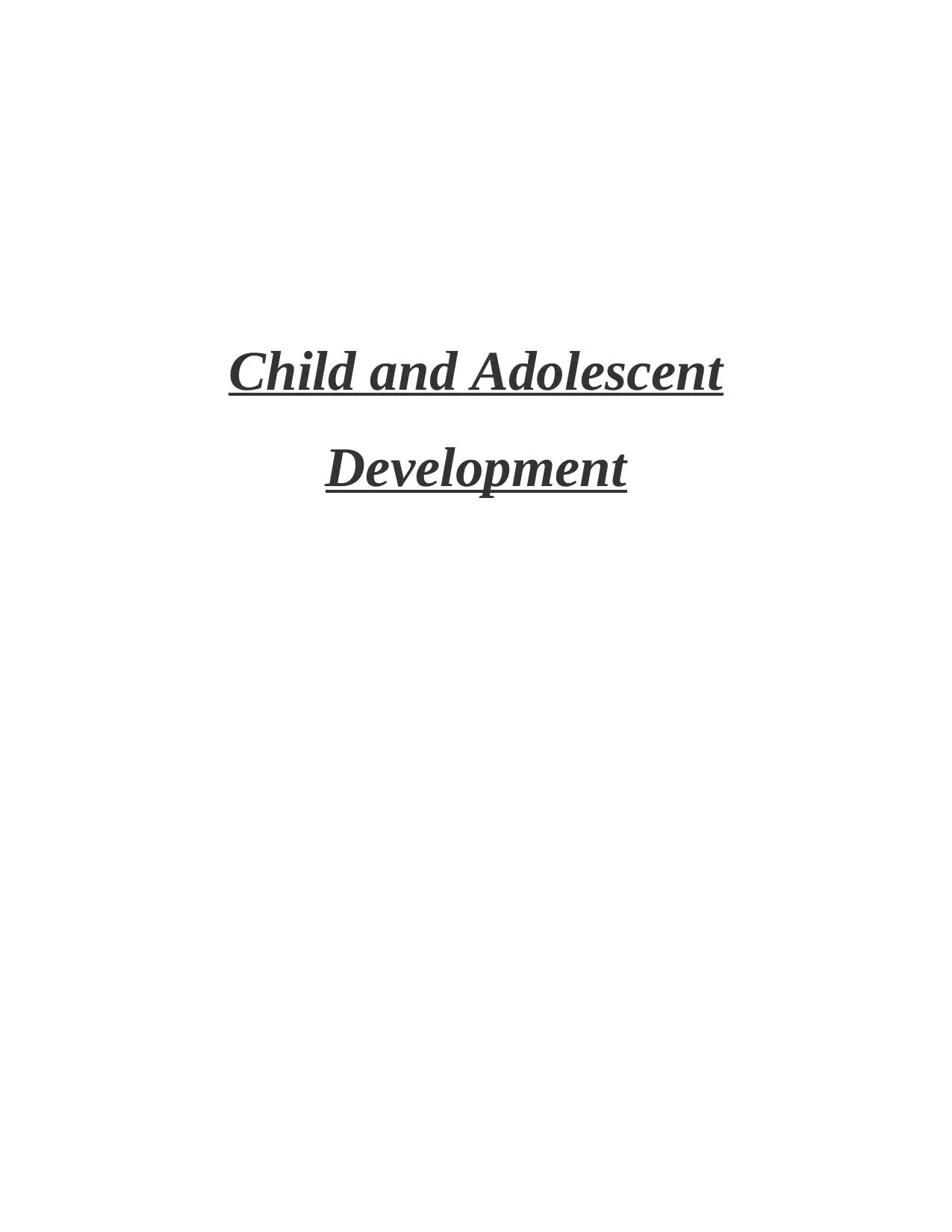
Child and Adolescent
Development
Development
Secure Best Marks with AI Grader
Need help grading? Try our AI Grader for instant feedback on your assignments.
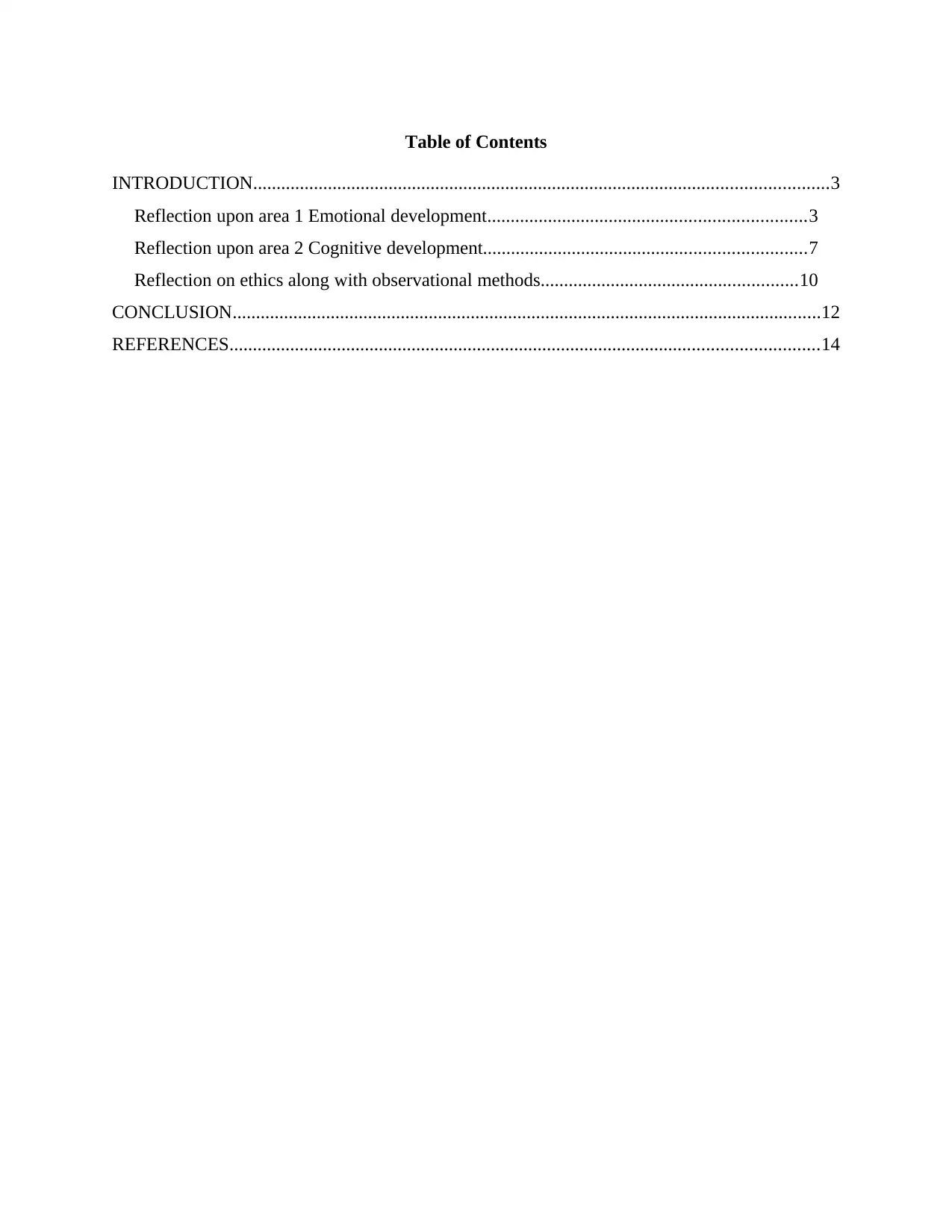
Table of Contents
INTRODUCTION...........................................................................................................................3
Reflection upon area 1 Emotional development....................................................................3
Reflection upon area 2 Cognitive development.....................................................................7
Reflection on ethics along with observational methods.......................................................10
CONCLUSION..............................................................................................................................12
REFERENCES..............................................................................................................................14
INTRODUCTION...........................................................................................................................3
Reflection upon area 1 Emotional development....................................................................3
Reflection upon area 2 Cognitive development.....................................................................7
Reflection on ethics along with observational methods.......................................................10
CONCLUSION..............................................................................................................................12
REFERENCES..............................................................................................................................14
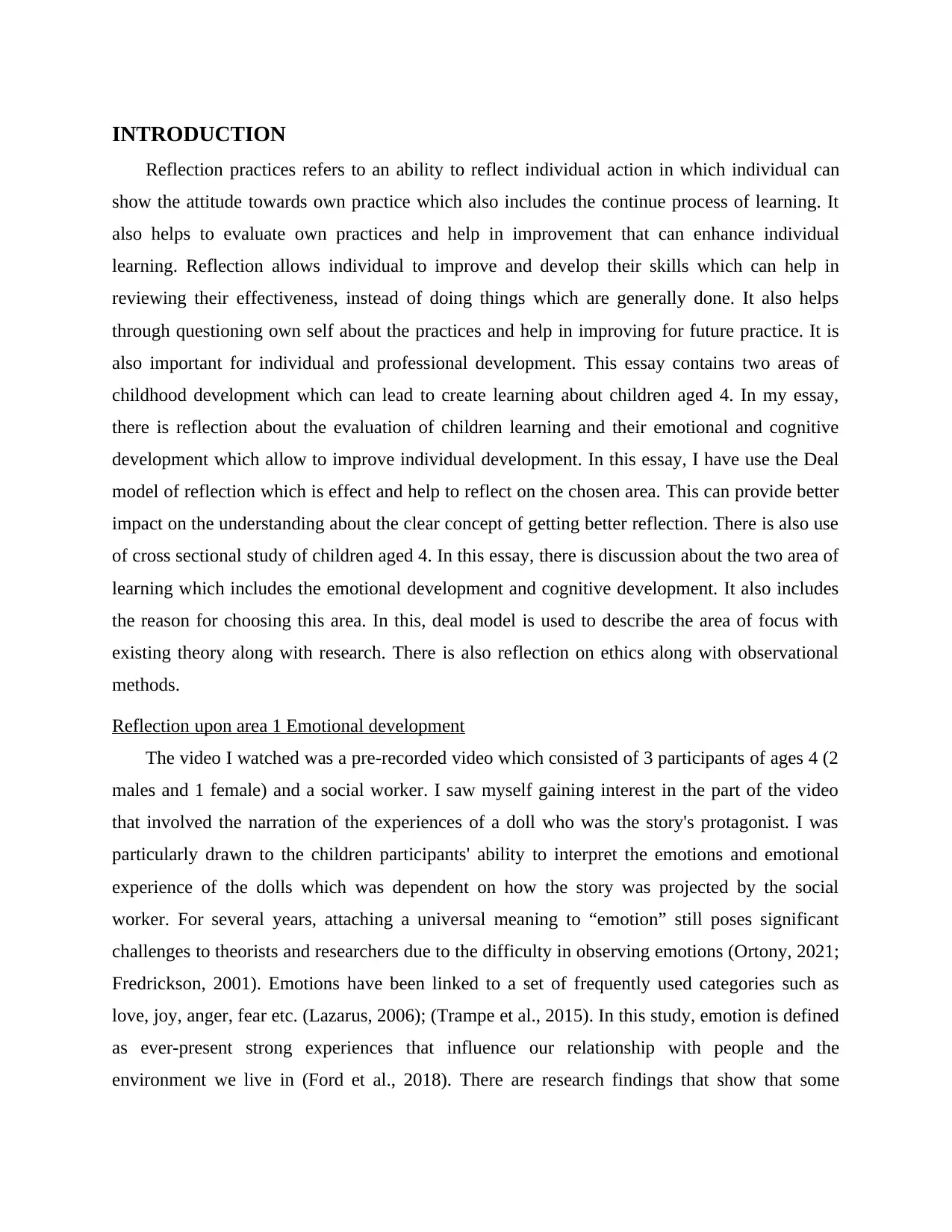
INTRODUCTION
Reflection practices refers to an ability to reflect individual action in which individual can
show the attitude towards own practice which also includes the continue process of learning. It
also helps to evaluate own practices and help in improvement that can enhance individual
learning. Reflection allows individual to improve and develop their skills which can help in
reviewing their effectiveness, instead of doing things which are generally done. It also helps
through questioning own self about the practices and help in improving for future practice. It is
also important for individual and professional development. This essay contains two areas of
childhood development which can lead to create learning about children aged 4. In my essay,
there is reflection about the evaluation of children learning and their emotional and cognitive
development which allow to improve individual development. In this essay, I have use the Deal
model of reflection which is effect and help to reflect on the chosen area. This can provide better
impact on the understanding about the clear concept of getting better reflection. There is also use
of cross sectional study of children aged 4. In this essay, there is discussion about the two area of
learning which includes the emotional development and cognitive development. It also includes
the reason for choosing this area. In this, deal model is used to describe the area of focus with
existing theory along with research. There is also reflection on ethics along with observational
methods.
Reflection upon area 1 Emotional development
The video I watched was a pre-recorded video which consisted of 3 participants of ages 4 (2
males and 1 female) and a social worker. I saw myself gaining interest in the part of the video
that involved the narration of the experiences of a doll who was the story's protagonist. I was
particularly drawn to the children participants' ability to interpret the emotions and emotional
experience of the dolls which was dependent on how the story was projected by the social
worker. For several years, attaching a universal meaning to “emotion” still poses significant
challenges to theorists and researchers due to the difficulty in observing emotions (Ortony, 2021;
Fredrickson, 2001). Emotions have been linked to a set of frequently used categories such as
love, joy, anger, fear etc. (Lazarus, 2006); (Trampe et al., 2015). In this study, emotion is defined
as ever-present strong experiences that influence our relationship with people and the
environment we live in (Ford et al., 2018). There are research findings that show that some
Reflection practices refers to an ability to reflect individual action in which individual can
show the attitude towards own practice which also includes the continue process of learning. It
also helps to evaluate own practices and help in improvement that can enhance individual
learning. Reflection allows individual to improve and develop their skills which can help in
reviewing their effectiveness, instead of doing things which are generally done. It also helps
through questioning own self about the practices and help in improving for future practice. It is
also important for individual and professional development. This essay contains two areas of
childhood development which can lead to create learning about children aged 4. In my essay,
there is reflection about the evaluation of children learning and their emotional and cognitive
development which allow to improve individual development. In this essay, I have use the Deal
model of reflection which is effect and help to reflect on the chosen area. This can provide better
impact on the understanding about the clear concept of getting better reflection. There is also use
of cross sectional study of children aged 4. In this essay, there is discussion about the two area of
learning which includes the emotional development and cognitive development. It also includes
the reason for choosing this area. In this, deal model is used to describe the area of focus with
existing theory along with research. There is also reflection on ethics along with observational
methods.
Reflection upon area 1 Emotional development
The video I watched was a pre-recorded video which consisted of 3 participants of ages 4 (2
males and 1 female) and a social worker. I saw myself gaining interest in the part of the video
that involved the narration of the experiences of a doll who was the story's protagonist. I was
particularly drawn to the children participants' ability to interpret the emotions and emotional
experience of the dolls which was dependent on how the story was projected by the social
worker. For several years, attaching a universal meaning to “emotion” still poses significant
challenges to theorists and researchers due to the difficulty in observing emotions (Ortony, 2021;
Fredrickson, 2001). Emotions have been linked to a set of frequently used categories such as
love, joy, anger, fear etc. (Lazarus, 2006); (Trampe et al., 2015). In this study, emotion is defined
as ever-present strong experiences that influence our relationship with people and the
environment we live in (Ford et al., 2018). There are research findings that show that some
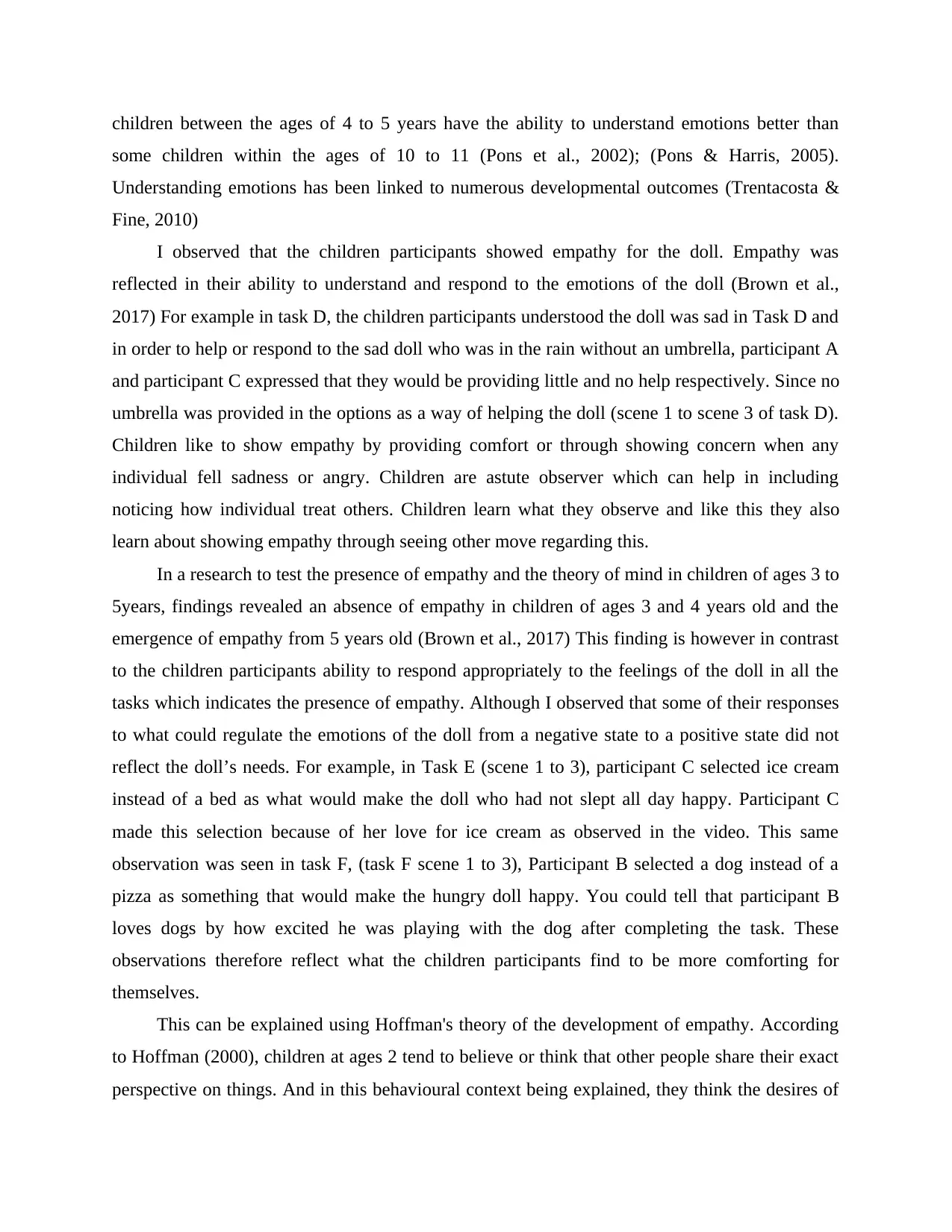
children between the ages of 4 to 5 years have the ability to understand emotions better than
some children within the ages of 10 to 11 (Pons et al., 2002); (Pons & Harris, 2005).
Understanding emotions has been linked to numerous developmental outcomes (Trentacosta &
Fine, 2010)
I observed that the children participants showed empathy for the doll. Empathy was
reflected in their ability to understand and respond to the emotions of the doll (Brown et al.,
2017) For example in task D, the children participants understood the doll was sad in Task D and
in order to help or respond to the sad doll who was in the rain without an umbrella, participant A
and participant C expressed that they would be providing little and no help respectively. Since no
umbrella was provided in the options as a way of helping the doll (scene 1 to scene 3 of task D).
Children like to show empathy by providing comfort or through showing concern when any
individual fell sadness or angry. Children are astute observer which can help in including
noticing how individual treat others. Children learn what they observe and like this they also
learn about showing empathy through seeing other move regarding this.
In a research to test the presence of empathy and the theory of mind in children of ages 3 to
5years, findings revealed an absence of empathy in children of ages 3 and 4 years old and the
emergence of empathy from 5 years old (Brown et al., 2017) This finding is however in contrast
to the children participants ability to respond appropriately to the feelings of the doll in all the
tasks which indicates the presence of empathy. Although I observed that some of their responses
to what could regulate the emotions of the doll from a negative state to a positive state did not
reflect the doll’s needs. For example, in Task E (scene 1 to 3), participant C selected ice cream
instead of a bed as what would make the doll who had not slept all day happy. Participant C
made this selection because of her love for ice cream as observed in the video. This same
observation was seen in task F, (task F scene 1 to 3), Participant B selected a dog instead of a
pizza as something that would make the hungry doll happy. You could tell that participant B
loves dogs by how excited he was playing with the dog after completing the task. These
observations therefore reflect what the children participants find to be more comforting for
themselves.
This can be explained using Hoffman's theory of the development of empathy. According
to Hoffman (2000), children at ages 2 tend to believe or think that other people share their exact
perspective on things. And in this behavioural context being explained, they think the desires of
some children within the ages of 10 to 11 (Pons et al., 2002); (Pons & Harris, 2005).
Understanding emotions has been linked to numerous developmental outcomes (Trentacosta &
Fine, 2010)
I observed that the children participants showed empathy for the doll. Empathy was
reflected in their ability to understand and respond to the emotions of the doll (Brown et al.,
2017) For example in task D, the children participants understood the doll was sad in Task D and
in order to help or respond to the sad doll who was in the rain without an umbrella, participant A
and participant C expressed that they would be providing little and no help respectively. Since no
umbrella was provided in the options as a way of helping the doll (scene 1 to scene 3 of task D).
Children like to show empathy by providing comfort or through showing concern when any
individual fell sadness or angry. Children are astute observer which can help in including
noticing how individual treat others. Children learn what they observe and like this they also
learn about showing empathy through seeing other move regarding this.
In a research to test the presence of empathy and the theory of mind in children of ages 3 to
5years, findings revealed an absence of empathy in children of ages 3 and 4 years old and the
emergence of empathy from 5 years old (Brown et al., 2017) This finding is however in contrast
to the children participants ability to respond appropriately to the feelings of the doll in all the
tasks which indicates the presence of empathy. Although I observed that some of their responses
to what could regulate the emotions of the doll from a negative state to a positive state did not
reflect the doll’s needs. For example, in Task E (scene 1 to 3), participant C selected ice cream
instead of a bed as what would make the doll who had not slept all day happy. Participant C
made this selection because of her love for ice cream as observed in the video. This same
observation was seen in task F, (task F scene 1 to 3), Participant B selected a dog instead of a
pizza as something that would make the hungry doll happy. You could tell that participant B
loves dogs by how excited he was playing with the dog after completing the task. These
observations therefore reflect what the children participants find to be more comforting for
themselves.
This can be explained using Hoffman's theory of the development of empathy. According
to Hoffman (2000), children at ages 2 tend to believe or think that other people share their exact
perspective on things. And in this behavioural context being explained, they think the desires of
Secure Best Marks with AI Grader
Need help grading? Try our AI Grader for instant feedback on your assignments.
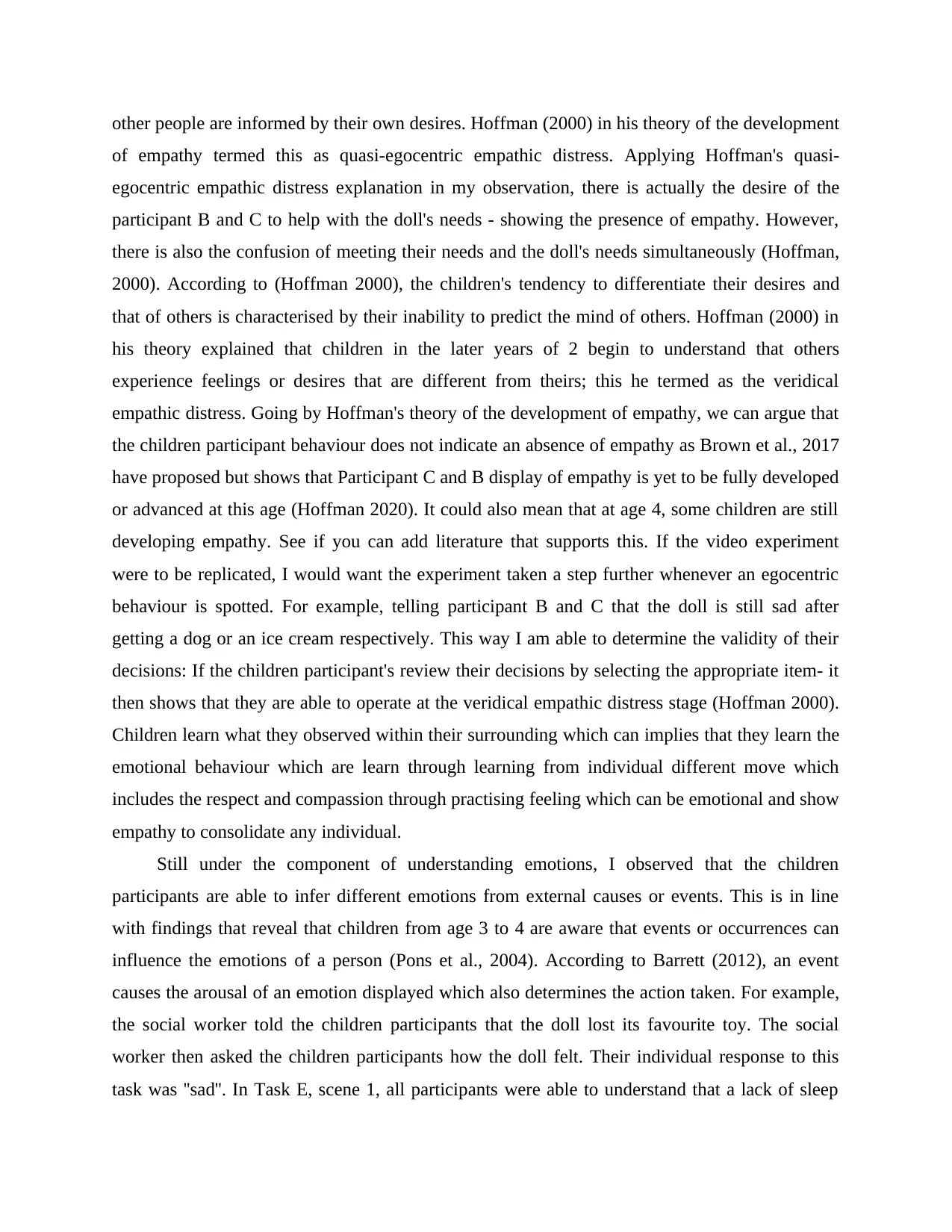
other people are informed by their own desires. Hoffman (2000) in his theory of the development
of empathy termed this as quasi-egocentric empathic distress. Applying Hoffman's quasi-
egocentric empathic distress explanation in my observation, there is actually the desire of the
participant B and C to help with the doll's needs - showing the presence of empathy. However,
there is also the confusion of meeting their needs and the doll's needs simultaneously (Hoffman,
2000). According to (Hoffman 2000), the children's tendency to differentiate their desires and
that of others is characterised by their inability to predict the mind of others. Hoffman (2000) in
his theory explained that children in the later years of 2 begin to understand that others
experience feelings or desires that are different from theirs; this he termed as the veridical
empathic distress. Going by Hoffman's theory of the development of empathy, we can argue that
the children participant behaviour does not indicate an absence of empathy as Brown et al., 2017
have proposed but shows that Participant C and B display of empathy is yet to be fully developed
or advanced at this age (Hoffman 2020). It could also mean that at age 4, some children are still
developing empathy. See if you can add literature that supports this. If the video experiment
were to be replicated, I would want the experiment taken a step further whenever an egocentric
behaviour is spotted. For example, telling participant B and C that the doll is still sad after
getting a dog or an ice cream respectively. This way I am able to determine the validity of their
decisions: If the children participant's review their decisions by selecting the appropriate item- it
then shows that they are able to operate at the veridical empathic distress stage (Hoffman 2000).
Children learn what they observed within their surrounding which can implies that they learn the
emotional behaviour which are learn through learning from individual different move which
includes the respect and compassion through practising feeling which can be emotional and show
empathy to consolidate any individual.
Still under the component of understanding emotions, I observed that the children
participants are able to infer different emotions from external causes or events. This is in line
with findings that reveal that children from age 3 to 4 are aware that events or occurrences can
influence the emotions of a person (Pons et al., 2004). According to Barrett (2012), an event
causes the arousal of an emotion displayed which also determines the action taken. For example,
the social worker told the children participants that the doll lost its favourite toy. The social
worker then asked the children participants how the doll felt. Their individual response to this
task was ''sad''. In Task E, scene 1, all participants were able to understand that a lack of sleep
of empathy termed this as quasi-egocentric empathic distress. Applying Hoffman's quasi-
egocentric empathic distress explanation in my observation, there is actually the desire of the
participant B and C to help with the doll's needs - showing the presence of empathy. However,
there is also the confusion of meeting their needs and the doll's needs simultaneously (Hoffman,
2000). According to (Hoffman 2000), the children's tendency to differentiate their desires and
that of others is characterised by their inability to predict the mind of others. Hoffman (2000) in
his theory explained that children in the later years of 2 begin to understand that others
experience feelings or desires that are different from theirs; this he termed as the veridical
empathic distress. Going by Hoffman's theory of the development of empathy, we can argue that
the children participant behaviour does not indicate an absence of empathy as Brown et al., 2017
have proposed but shows that Participant C and B display of empathy is yet to be fully developed
or advanced at this age (Hoffman 2020). It could also mean that at age 4, some children are still
developing empathy. See if you can add literature that supports this. If the video experiment
were to be replicated, I would want the experiment taken a step further whenever an egocentric
behaviour is spotted. For example, telling participant B and C that the doll is still sad after
getting a dog or an ice cream respectively. This way I am able to determine the validity of their
decisions: If the children participant's review their decisions by selecting the appropriate item- it
then shows that they are able to operate at the veridical empathic distress stage (Hoffman 2000).
Children learn what they observed within their surrounding which can implies that they learn the
emotional behaviour which are learn through learning from individual different move which
includes the respect and compassion through practising feeling which can be emotional and show
empathy to consolidate any individual.
Still under the component of understanding emotions, I observed that the children
participants are able to infer different emotions from external causes or events. This is in line
with findings that reveal that children from age 3 to 4 are aware that events or occurrences can
influence the emotions of a person (Pons et al., 2004). According to Barrett (2012), an event
causes the arousal of an emotion displayed which also determines the action taken. For example,
the social worker told the children participants that the doll lost its favourite toy. The social
worker then asked the children participants how the doll felt. Their individual response to this
task was ''sad''. In Task E, scene 1, all participants were able to understand that a lack of sleep
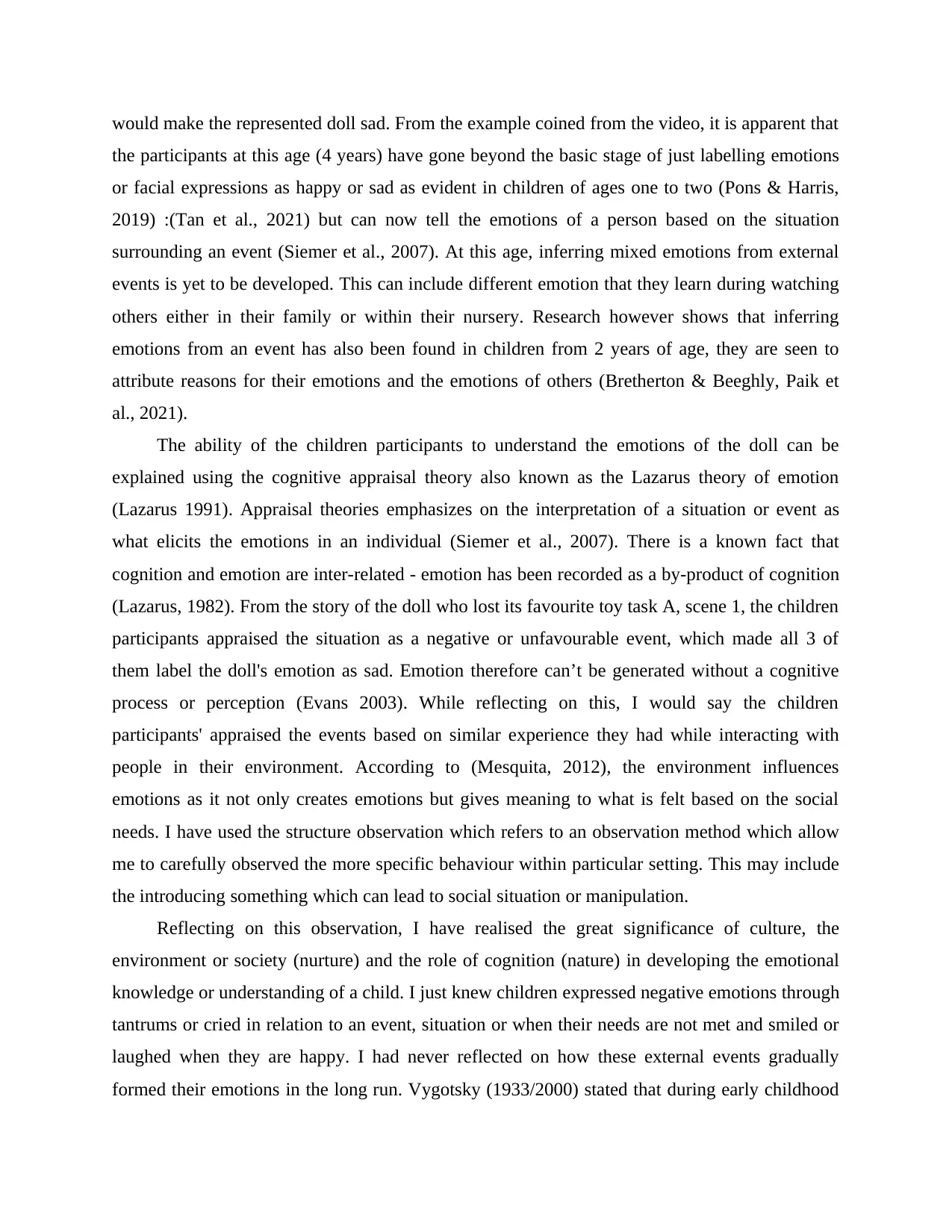
would make the represented doll sad. From the example coined from the video, it is apparent that
the participants at this age (4 years) have gone beyond the basic stage of just labelling emotions
or facial expressions as happy or sad as evident in children of ages one to two (Pons & Harris,
2019) :(Tan et al., 2021) but can now tell the emotions of a person based on the situation
surrounding an event (Siemer et al., 2007). At this age, inferring mixed emotions from external
events is yet to be developed. This can include different emotion that they learn during watching
others either in their family or within their nursery. Research however shows that inferring
emotions from an event has also been found in children from 2 years of age, they are seen to
attribute reasons for their emotions and the emotions of others (Bretherton & Beeghly, Paik et
al., 2021).
The ability of the children participants to understand the emotions of the doll can be
explained using the cognitive appraisal theory also known as the Lazarus theory of emotion
(Lazarus 1991). Appraisal theories emphasizes on the interpretation of a situation or event as
what elicits the emotions in an individual (Siemer et al., 2007). There is a known fact that
cognition and emotion are inter-related - emotion has been recorded as a by-product of cognition
(Lazarus, 1982). From the story of the doll who lost its favourite toy task A, scene 1, the children
participants appraised the situation as a negative or unfavourable event, which made all 3 of
them label the doll's emotion as sad. Emotion therefore can’t be generated without a cognitive
process or perception (Evans 2003). While reflecting on this, I would say the children
participants' appraised the events based on similar experience they had while interacting with
people in their environment. According to (Mesquita, 2012), the environment influences
emotions as it not only creates emotions but gives meaning to what is felt based on the social
needs. I have used the structure observation which refers to an observation method which allow
me to carefully observed the more specific behaviour within particular setting. This may include
the introducing something which can lead to social situation or manipulation.
Reflecting on this observation, I have realised the great significance of culture, the
environment or society (nurture) and the role of cognition (nature) in developing the emotional
knowledge or understanding of a child. I just knew children expressed negative emotions through
tantrums or cried in relation to an event, situation or when their needs are not met and smiled or
laughed when they are happy. I had never reflected on how these external events gradually
formed their emotions in the long run. Vygotsky (1933/2000) stated that during early childhood
the participants at this age (4 years) have gone beyond the basic stage of just labelling emotions
or facial expressions as happy or sad as evident in children of ages one to two (Pons & Harris,
2019) :(Tan et al., 2021) but can now tell the emotions of a person based on the situation
surrounding an event (Siemer et al., 2007). At this age, inferring mixed emotions from external
events is yet to be developed. This can include different emotion that they learn during watching
others either in their family or within their nursery. Research however shows that inferring
emotions from an event has also been found in children from 2 years of age, they are seen to
attribute reasons for their emotions and the emotions of others (Bretherton & Beeghly, Paik et
al., 2021).
The ability of the children participants to understand the emotions of the doll can be
explained using the cognitive appraisal theory also known as the Lazarus theory of emotion
(Lazarus 1991). Appraisal theories emphasizes on the interpretation of a situation or event as
what elicits the emotions in an individual (Siemer et al., 2007). There is a known fact that
cognition and emotion are inter-related - emotion has been recorded as a by-product of cognition
(Lazarus, 1982). From the story of the doll who lost its favourite toy task A, scene 1, the children
participants appraised the situation as a negative or unfavourable event, which made all 3 of
them label the doll's emotion as sad. Emotion therefore can’t be generated without a cognitive
process or perception (Evans 2003). While reflecting on this, I would say the children
participants' appraised the events based on similar experience they had while interacting with
people in their environment. According to (Mesquita, 2012), the environment influences
emotions as it not only creates emotions but gives meaning to what is felt based on the social
needs. I have used the structure observation which refers to an observation method which allow
me to carefully observed the more specific behaviour within particular setting. This may include
the introducing something which can lead to social situation or manipulation.
Reflecting on this observation, I have realised the great significance of culture, the
environment or society (nurture) and the role of cognition (nature) in developing the emotional
knowledge or understanding of a child. I just knew children expressed negative emotions through
tantrums or cried in relation to an event, situation or when their needs are not met and smiled or
laughed when they are happy. I had never reflected on how these external events gradually
formed their emotions in the long run. Vygotsky (1933/2000) stated that during early childhood
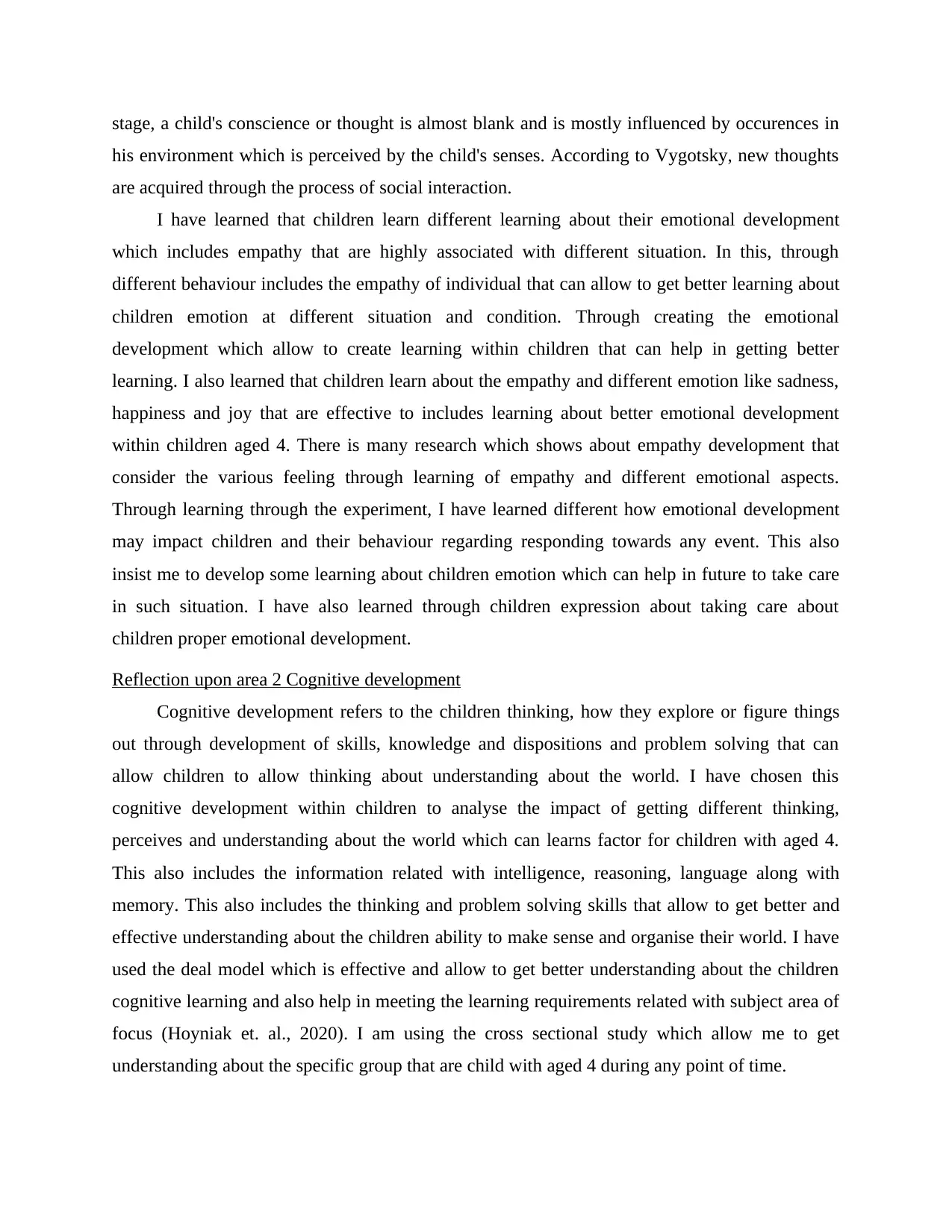
stage, a child's conscience or thought is almost blank and is mostly influenced by occurences in
his environment which is perceived by the child's senses. According to Vygotsky, new thoughts
are acquired through the process of social interaction.
I have learned that children learn different learning about their emotional development
which includes empathy that are highly associated with different situation. In this, through
different behaviour includes the empathy of individual that can allow to get better learning about
children emotion at different situation and condition. Through creating the emotional
development which allow to create learning within children that can help in getting better
learning. I also learned that children learn about the empathy and different emotion like sadness,
happiness and joy that are effective to includes learning about better emotional development
within children aged 4. There is many research which shows about empathy development that
consider the various feeling through learning of empathy and different emotional aspects.
Through learning through the experiment, I have learned different how emotional development
may impact children and their behaviour regarding responding towards any event. This also
insist me to develop some learning about children emotion which can help in future to take care
in such situation. I have also learned through children expression about taking care about
children proper emotional development.
Reflection upon area 2 Cognitive development
Cognitive development refers to the children thinking, how they explore or figure things
out through development of skills, knowledge and dispositions and problem solving that can
allow children to allow thinking about understanding about the world. I have chosen this
cognitive development within children to analyse the impact of getting different thinking,
perceives and understanding about the world which can learns factor for children with aged 4.
This also includes the information related with intelligence, reasoning, language along with
memory. This also includes the thinking and problem solving skills that allow to get better and
effective understanding about the children ability to make sense and organise their world. I have
used the deal model which is effective and allow to get better understanding about the children
cognitive learning and also help in meeting the learning requirements related with subject area of
focus (Hoyniak et. al., 2020). I am using the cross sectional study which allow me to get
understanding about the specific group that are child with aged 4 during any point of time.
his environment which is perceived by the child's senses. According to Vygotsky, new thoughts
are acquired through the process of social interaction.
I have learned that children learn different learning about their emotional development
which includes empathy that are highly associated with different situation. In this, through
different behaviour includes the empathy of individual that can allow to get better learning about
children emotion at different situation and condition. Through creating the emotional
development which allow to create learning within children that can help in getting better
learning. I also learned that children learn about the empathy and different emotion like sadness,
happiness and joy that are effective to includes learning about better emotional development
within children aged 4. There is many research which shows about empathy development that
consider the various feeling through learning of empathy and different emotional aspects.
Through learning through the experiment, I have learned different how emotional development
may impact children and their behaviour regarding responding towards any event. This also
insist me to develop some learning about children emotion which can help in future to take care
in such situation. I have also learned through children expression about taking care about
children proper emotional development.
Reflection upon area 2 Cognitive development
Cognitive development refers to the children thinking, how they explore or figure things
out through development of skills, knowledge and dispositions and problem solving that can
allow children to allow thinking about understanding about the world. I have chosen this
cognitive development within children to analyse the impact of getting different thinking,
perceives and understanding about the world which can learns factor for children with aged 4.
This also includes the information related with intelligence, reasoning, language along with
memory. This also includes the thinking and problem solving skills that allow to get better and
effective understanding about the children ability to make sense and organise their world. I have
used the deal model which is effective and allow to get better understanding about the children
cognitive learning and also help in meeting the learning requirements related with subject area of
focus (Hoyniak et. al., 2020). I am using the cross sectional study which allow me to get
understanding about the specific group that are child with aged 4 during any point of time.
Paraphrase This Document
Need a fresh take? Get an instant paraphrase of this document with our AI Paraphraser
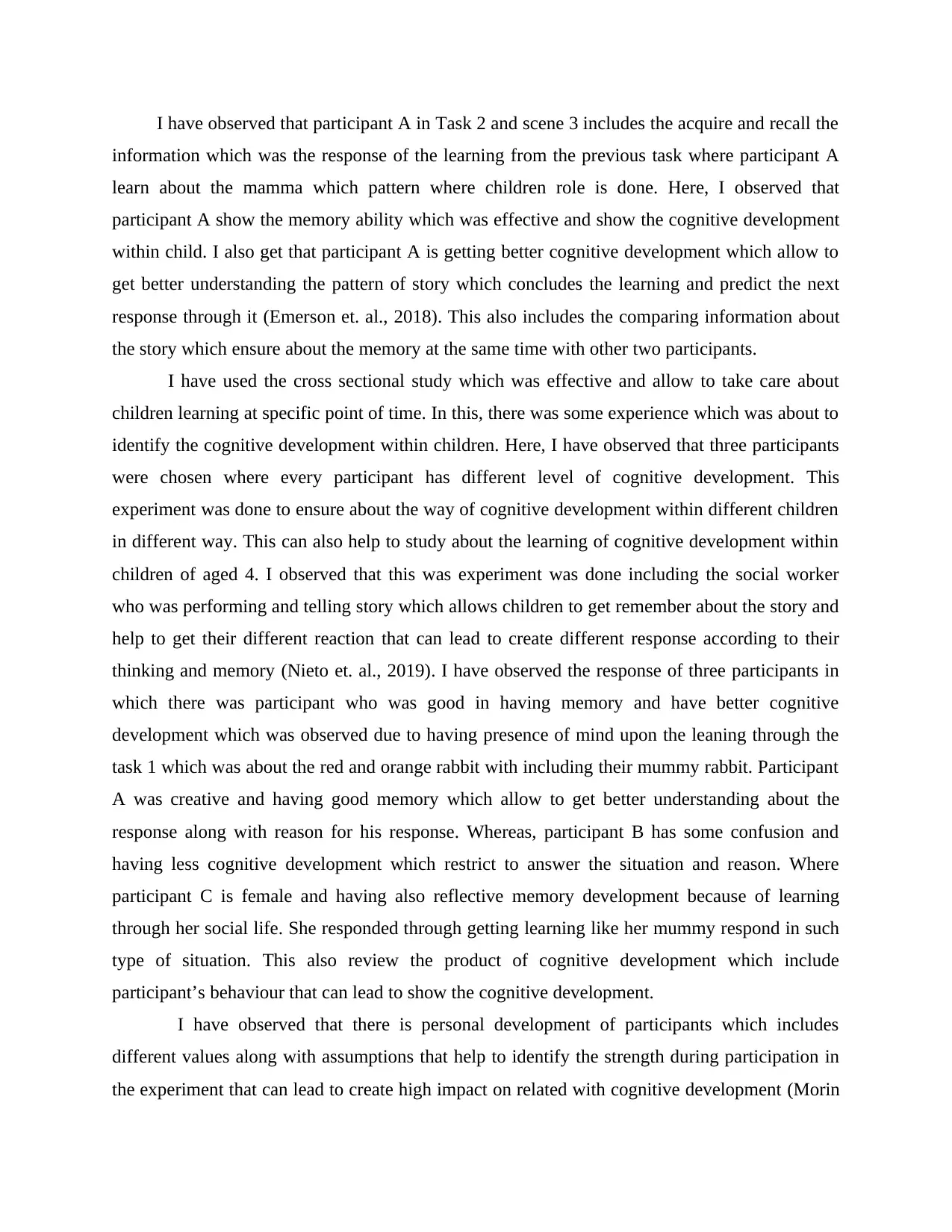
I have observed that participant A in Task 2 and scene 3 includes the acquire and recall the
information which was the response of the learning from the previous task where participant A
learn about the mamma which pattern where children role is done. Here, I observed that
participant A show the memory ability which was effective and show the cognitive development
within child. I also get that participant A is getting better cognitive development which allow to
get better understanding the pattern of story which concludes the learning and predict the next
response through it (Emerson et. al., 2018). This also includes the comparing information about
the story which ensure about the memory at the same time with other two participants.
I have used the cross sectional study which was effective and allow to take care about
children learning at specific point of time. In this, there was some experience which was about to
identify the cognitive development within children. Here, I have observed that three participants
were chosen where every participant has different level of cognitive development. This
experiment was done to ensure about the way of cognitive development within different children
in different way. This can also help to study about the learning of cognitive development within
children of aged 4. I observed that this was experiment was done including the social worker
who was performing and telling story which allows children to get remember about the story and
help to get their different reaction that can lead to create different response according to their
thinking and memory (Nieto et. al., 2019). I have observed the response of three participants in
which there was participant who was good in having memory and have better cognitive
development which was observed due to having presence of mind upon the leaning through the
task 1 which was about the red and orange rabbit with including their mummy rabbit. Participant
A was creative and having good memory which allow to get better understanding about the
response along with reason for his response. Whereas, participant B has some confusion and
having less cognitive development which restrict to answer the situation and reason. Where
participant C is female and having also reflective memory development because of learning
through her social life. She responded through getting learning like her mummy respond in such
type of situation. This also review the product of cognitive development which include
participant’s behaviour that can lead to show the cognitive development.
I have observed that there is personal development of participants which includes
different values along with assumptions that help to identify the strength during participation in
the experiment that can lead to create high impact on related with cognitive development (Morin
information which was the response of the learning from the previous task where participant A
learn about the mamma which pattern where children role is done. Here, I observed that
participant A show the memory ability which was effective and show the cognitive development
within child. I also get that participant A is getting better cognitive development which allow to
get better understanding the pattern of story which concludes the learning and predict the next
response through it (Emerson et. al., 2018). This also includes the comparing information about
the story which ensure about the memory at the same time with other two participants.
I have used the cross sectional study which was effective and allow to take care about
children learning at specific point of time. In this, there was some experience which was about to
identify the cognitive development within children. Here, I have observed that three participants
were chosen where every participant has different level of cognitive development. This
experiment was done to ensure about the way of cognitive development within different children
in different way. This can also help to study about the learning of cognitive development within
children of aged 4. I observed that this was experiment was done including the social worker
who was performing and telling story which allows children to get remember about the story and
help to get their different reaction that can lead to create different response according to their
thinking and memory (Nieto et. al., 2019). I have observed the response of three participants in
which there was participant who was good in having memory and have better cognitive
development which was observed due to having presence of mind upon the leaning through the
task 1 which was about the red and orange rabbit with including their mummy rabbit. Participant
A was creative and having good memory which allow to get better understanding about the
response along with reason for his response. Whereas, participant B has some confusion and
having less cognitive development which restrict to answer the situation and reason. Where
participant C is female and having also reflective memory development because of learning
through her social life. She responded through getting learning like her mummy respond in such
type of situation. This also review the product of cognitive development which include
participant’s behaviour that can lead to show the cognitive development.
I have observed that there is personal development of participants which includes
different values along with assumptions that help to identify the strength during participation in
the experiment that can lead to create high impact on related with cognitive development (Morin
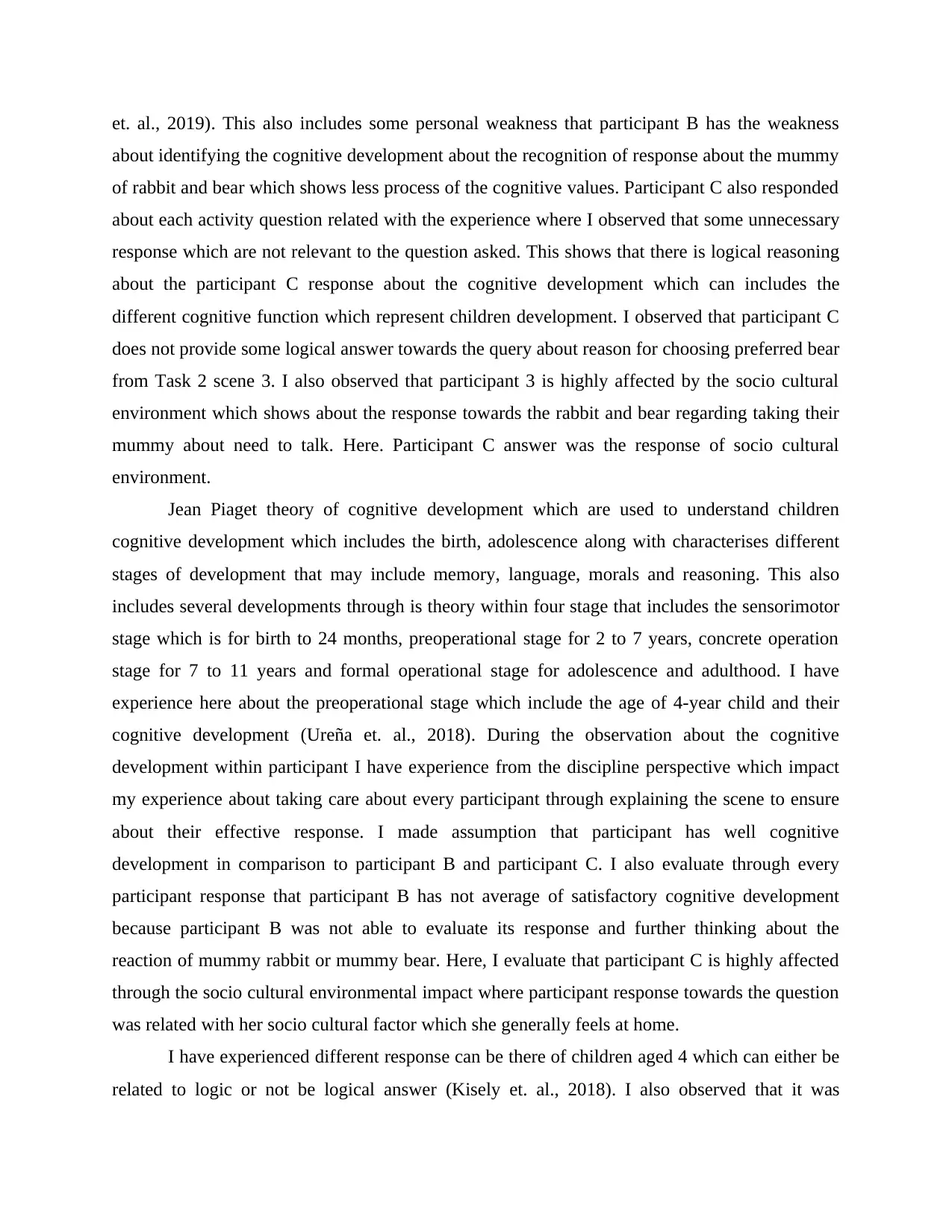
et. al., 2019). This also includes some personal weakness that participant B has the weakness
about identifying the cognitive development about the recognition of response about the mummy
of rabbit and bear which shows less process of the cognitive values. Participant C also responded
about each activity question related with the experience where I observed that some unnecessary
response which are not relevant to the question asked. This shows that there is logical reasoning
about the participant C response about the cognitive development which can includes the
different cognitive function which represent children development. I observed that participant C
does not provide some logical answer towards the query about reason for choosing preferred bear
from Task 2 scene 3. I also observed that participant 3 is highly affected by the socio cultural
environment which shows about the response towards the rabbit and bear regarding taking their
mummy about need to talk. Here. Participant C answer was the response of socio cultural
environment.
Jean Piaget theory of cognitive development which are used to understand children
cognitive development which includes the birth, adolescence along with characterises different
stages of development that may include memory, language, morals and reasoning. This also
includes several developments through is theory within four stage that includes the sensorimotor
stage which is for birth to 24 months, preoperational stage for 2 to 7 years, concrete operation
stage for 7 to 11 years and formal operational stage for adolescence and adulthood. I have
experience here about the preoperational stage which include the age of 4-year child and their
cognitive development (Ureña et. al., 2018). During the observation about the cognitive
development within participant I have experience from the discipline perspective which impact
my experience about taking care about every participant through explaining the scene to ensure
about their effective response. I made assumption that participant has well cognitive
development in comparison to participant B and participant C. I also evaluate through every
participant response that participant B has not average of satisfactory cognitive development
because participant B was not able to evaluate its response and further thinking about the
reaction of mummy rabbit or mummy bear. Here, I evaluate that participant C is highly affected
through the socio cultural environmental impact where participant response towards the question
was related with her socio cultural factor which she generally feels at home.
I have experienced different response can be there of children aged 4 which can either be
related to logic or not be logical answer (Kisely et. al., 2018). I also observed that it was
about identifying the cognitive development about the recognition of response about the mummy
of rabbit and bear which shows less process of the cognitive values. Participant C also responded
about each activity question related with the experience where I observed that some unnecessary
response which are not relevant to the question asked. This shows that there is logical reasoning
about the participant C response about the cognitive development which can includes the
different cognitive function which represent children development. I observed that participant C
does not provide some logical answer towards the query about reason for choosing preferred bear
from Task 2 scene 3. I also observed that participant 3 is highly affected by the socio cultural
environment which shows about the response towards the rabbit and bear regarding taking their
mummy about need to talk. Here. Participant C answer was the response of socio cultural
environment.
Jean Piaget theory of cognitive development which are used to understand children
cognitive development which includes the birth, adolescence along with characterises different
stages of development that may include memory, language, morals and reasoning. This also
includes several developments through is theory within four stage that includes the sensorimotor
stage which is for birth to 24 months, preoperational stage for 2 to 7 years, concrete operation
stage for 7 to 11 years and formal operational stage for adolescence and adulthood. I have
experience here about the preoperational stage which include the age of 4-year child and their
cognitive development (Ureña et. al., 2018). During the observation about the cognitive
development within participant I have experience from the discipline perspective which impact
my experience about taking care about every participant through explaining the scene to ensure
about their effective response. I made assumption that participant has well cognitive
development in comparison to participant B and participant C. I also evaluate through every
participant response that participant B has not average of satisfactory cognitive development
because participant B was not able to evaluate its response and further thinking about the
reaction of mummy rabbit or mummy bear. Here, I evaluate that participant C is highly affected
through the socio cultural environmental impact where participant response towards the question
was related with her socio cultural factor which she generally feels at home.
I have experienced different response can be there of children aged 4 which can either be
related to logic or not be logical answer (Kisely et. al., 2018). I also observed that it was
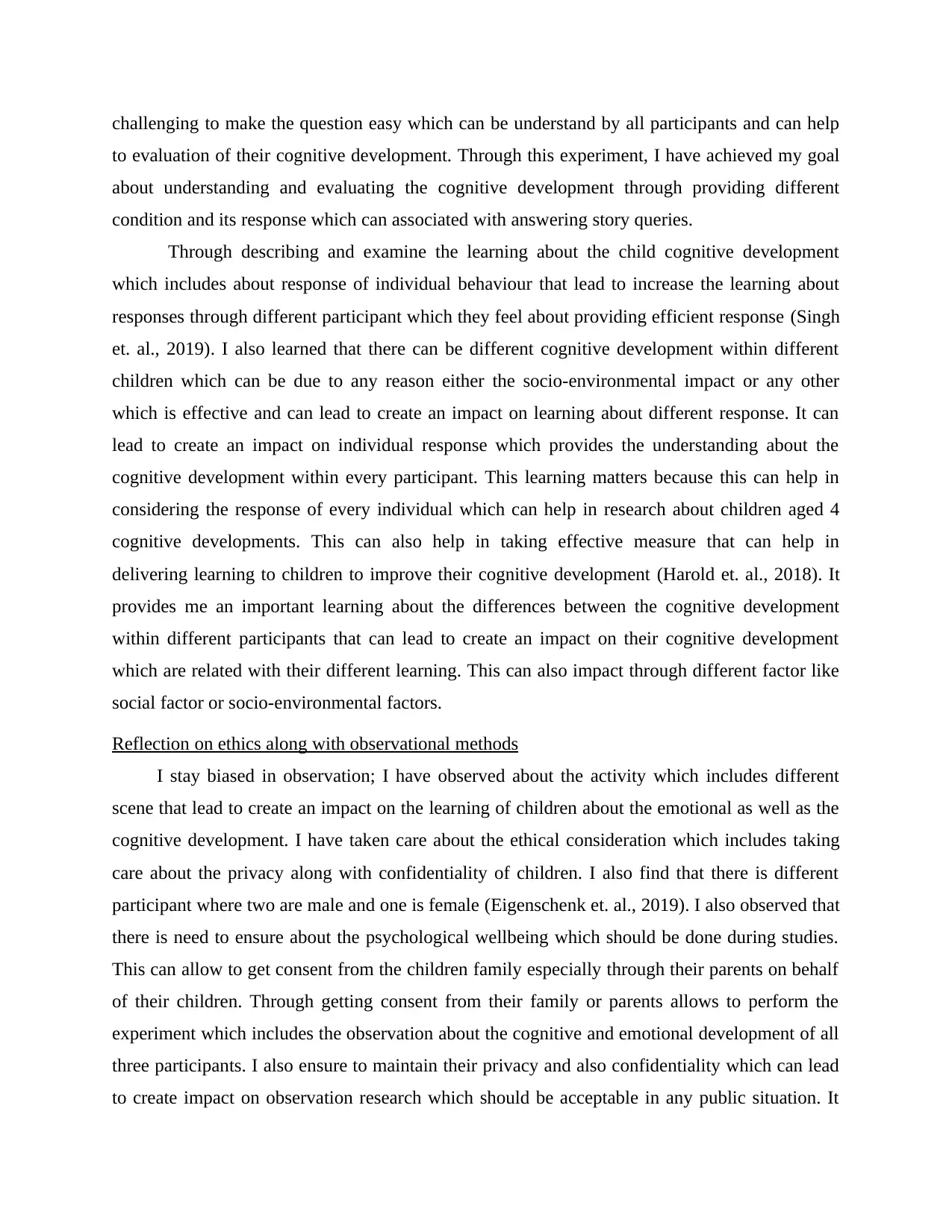
challenging to make the question easy which can be understand by all participants and can help
to evaluation of their cognitive development. Through this experiment, I have achieved my goal
about understanding and evaluating the cognitive development through providing different
condition and its response which can associated with answering story queries.
Through describing and examine the learning about the child cognitive development
which includes about response of individual behaviour that lead to increase the learning about
responses through different participant which they feel about providing efficient response (Singh
et. al., 2019). I also learned that there can be different cognitive development within different
children which can be due to any reason either the socio-environmental impact or any other
which is effective and can lead to create an impact on learning about different response. It can
lead to create an impact on individual response which provides the understanding about the
cognitive development within every participant. This learning matters because this can help in
considering the response of every individual which can help in research about children aged 4
cognitive developments. This can also help in taking effective measure that can help in
delivering learning to children to improve their cognitive development (Harold et. al., 2018). It
provides me an important learning about the differences between the cognitive development
within different participants that can lead to create an impact on their cognitive development
which are related with their different learning. This can also impact through different factor like
social factor or socio-environmental factors.
Reflection on ethics along with observational methods
I stay biased in observation; I have observed about the activity which includes different
scene that lead to create an impact on the learning of children about the emotional as well as the
cognitive development. I have taken care about the ethical consideration which includes taking
care about the privacy along with confidentiality of children. I also find that there is different
participant where two are male and one is female (Eigenschenk et. al., 2019). I also observed that
there is need to ensure about the psychological wellbeing which should be done during studies.
This can allow to get consent from the children family especially through their parents on behalf
of their children. Through getting consent from their family or parents allows to perform the
experiment which includes the observation about the cognitive and emotional development of all
three participants. I also ensure to maintain their privacy and also confidentiality which can lead
to create impact on observation research which should be acceptable in any public situation. It
to evaluation of their cognitive development. Through this experiment, I have achieved my goal
about understanding and evaluating the cognitive development through providing different
condition and its response which can associated with answering story queries.
Through describing and examine the learning about the child cognitive development
which includes about response of individual behaviour that lead to increase the learning about
responses through different participant which they feel about providing efficient response (Singh
et. al., 2019). I also learned that there can be different cognitive development within different
children which can be due to any reason either the socio-environmental impact or any other
which is effective and can lead to create an impact on learning about different response. It can
lead to create an impact on individual response which provides the understanding about the
cognitive development within every participant. This learning matters because this can help in
considering the response of every individual which can help in research about children aged 4
cognitive developments. This can also help in taking effective measure that can help in
delivering learning to children to improve their cognitive development (Harold et. al., 2018). It
provides me an important learning about the differences between the cognitive development
within different participants that can lead to create an impact on their cognitive development
which are related with their different learning. This can also impact through different factor like
social factor or socio-environmental factors.
Reflection on ethics along with observational methods
I stay biased in observation; I have observed about the activity which includes different
scene that lead to create an impact on the learning of children about the emotional as well as the
cognitive development. I have taken care about the ethical consideration which includes taking
care about the privacy along with confidentiality of children. I also find that there is different
participant where two are male and one is female (Eigenschenk et. al., 2019). I also observed that
there is need to ensure about the psychological wellbeing which should be done during studies.
This can allow to get consent from the children family especially through their parents on behalf
of their children. Through getting consent from their family or parents allows to perform the
experiment which includes the observation about the cognitive and emotional development of all
three participants. I also ensure to maintain their privacy and also confidentiality which can lead
to create impact on observation research which should be acceptable in any public situation. It
Secure Best Marks with AI Grader
Need help grading? Try our AI Grader for instant feedback on your assignments.
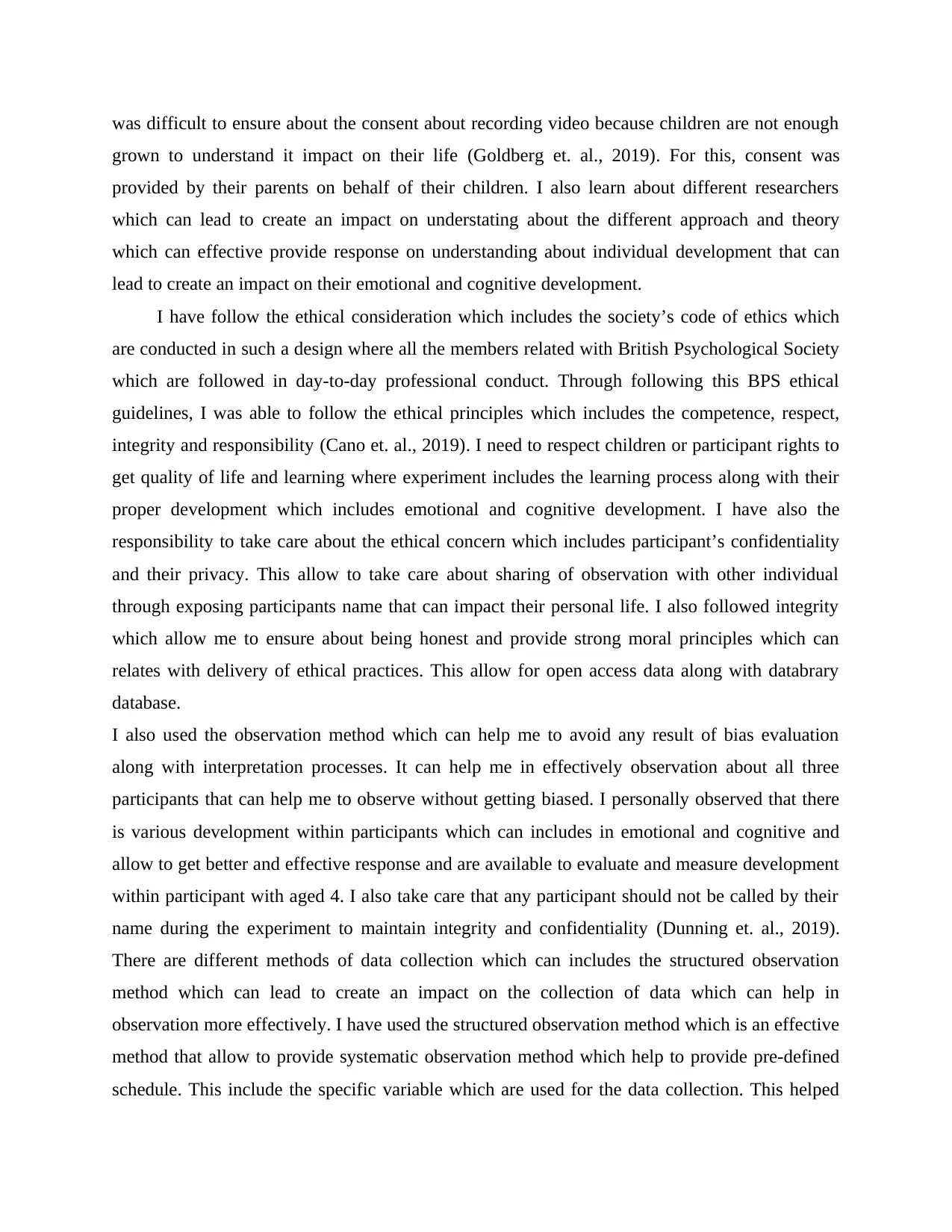
was difficult to ensure about the consent about recording video because children are not enough
grown to understand it impact on their life (Goldberg et. al., 2019). For this, consent was
provided by their parents on behalf of their children. I also learn about different researchers
which can lead to create an impact on understating about the different approach and theory
which can effective provide response on understanding about individual development that can
lead to create an impact on their emotional and cognitive development.
I have follow the ethical consideration which includes the society’s code of ethics which
are conducted in such a design where all the members related with British Psychological Society
which are followed in day-to-day professional conduct. Through following this BPS ethical
guidelines, I was able to follow the ethical principles which includes the competence, respect,
integrity and responsibility (Cano et. al., 2019). I need to respect children or participant rights to
get quality of life and learning where experiment includes the learning process along with their
proper development which includes emotional and cognitive development. I have also the
responsibility to take care about the ethical concern which includes participant’s confidentiality
and their privacy. This allow to take care about sharing of observation with other individual
through exposing participants name that can impact their personal life. I also followed integrity
which allow me to ensure about being honest and provide strong moral principles which can
relates with delivery of ethical practices. This allow for open access data along with databrary
database.
I also used the observation method which can help me to avoid any result of bias evaluation
along with interpretation processes. It can help me in effectively observation about all three
participants that can help me to observe without getting biased. I personally observed that there
is various development within participants which can includes in emotional and cognitive and
allow to get better and effective response and are available to evaluate and measure development
within participant with aged 4. I also take care that any participant should not be called by their
name during the experiment to maintain integrity and confidentiality (Dunning et. al., 2019).
There are different methods of data collection which can includes the structured observation
method which can lead to create an impact on the collection of data which can help in
observation more effectively. I have used the structured observation method which is an effective
method that allow to provide systematic observation method which help to provide pre-defined
schedule. This include the specific variable which are used for the data collection. This helped
grown to understand it impact on their life (Goldberg et. al., 2019). For this, consent was
provided by their parents on behalf of their children. I also learn about different researchers
which can lead to create an impact on understating about the different approach and theory
which can effective provide response on understanding about individual development that can
lead to create an impact on their emotional and cognitive development.
I have follow the ethical consideration which includes the society’s code of ethics which
are conducted in such a design where all the members related with British Psychological Society
which are followed in day-to-day professional conduct. Through following this BPS ethical
guidelines, I was able to follow the ethical principles which includes the competence, respect,
integrity and responsibility (Cano et. al., 2019). I need to respect children or participant rights to
get quality of life and learning where experiment includes the learning process along with their
proper development which includes emotional and cognitive development. I have also the
responsibility to take care about the ethical concern which includes participant’s confidentiality
and their privacy. This allow to take care about sharing of observation with other individual
through exposing participants name that can impact their personal life. I also followed integrity
which allow me to ensure about being honest and provide strong moral principles which can
relates with delivery of ethical practices. This allow for open access data along with databrary
database.
I also used the observation method which can help me to avoid any result of bias evaluation
along with interpretation processes. It can help me in effectively observation about all three
participants that can help me to observe without getting biased. I personally observed that there
is various development within participants which can includes in emotional and cognitive and
allow to get better and effective response and are available to evaluate and measure development
within participant with aged 4. I also take care that any participant should not be called by their
name during the experiment to maintain integrity and confidentiality (Dunning et. al., 2019).
There are different methods of data collection which can includes the structured observation
method which can lead to create an impact on the collection of data which can help in
observation more effectively. I have used the structured observation method which is an effective
method that allow to provide systematic observation method which help to provide pre-defined
schedule. This include the specific variable which are used for the data collection. This helped

me to observe the emotional and cognitive development within each participant without getting
biased and based on the collected data which are the response of the individual participants of the
experiment. This also helped me to get better and effective response in dealing with different
data that allow to get better evaluation of the response of each participants. There was a
limitation about the structured observation method which includes lack of validity which
includes the counting frequency (Liu et. al., 2021). This does not tell about the events meaning
where different observers may lead to same event with different categories.
CONCLUSION
From the above discussion, it can have concluded that for proper growth and development of
children there is need to ensure about the emotional and cognitive development which can lead
to create high impact on children learning. In this, through observing about different manner
related with proper development within children aged 4. There is difference in getting better
delivery of getting learning about the emotional and cognitive development which can ensure
about better learning to children. Emotional development plays an important role in creating
effeteness in children learning for their growth which can lead to create an impact on proper
development. Through emotional development children learn to reach in different situation that
are also effective for their future learning and life. Through this, they may learn to react on
different situation and develop some empathy regarding any situation which is human emotion.
Cognitive development can also learn by the children which help to provide the understanding
about delivery of cognition about their thinking, finding out things through developing their
skills, knowledge, and problem solving and disposition. These are effective which should be
learned by children to adopt the understanding about their thinking that can help in getting better
development. In this, there is various discussion about the emotional and cognitive development
which as associated with the overall children development. This may include different theory and
model along with literature which can be associated with children development. There is also
discussion about the ethical consideration and principles which should be followed during
reflection. This also exhibit the BPS ethical guidelines that can associated with different learning
about ethical consideration. It also includes the observation methods that are effective to
conclude the children emotional and cognitive responses.
biased and based on the collected data which are the response of the individual participants of the
experiment. This also helped me to get better and effective response in dealing with different
data that allow to get better evaluation of the response of each participants. There was a
limitation about the structured observation method which includes lack of validity which
includes the counting frequency (Liu et. al., 2021). This does not tell about the events meaning
where different observers may lead to same event with different categories.
CONCLUSION
From the above discussion, it can have concluded that for proper growth and development of
children there is need to ensure about the emotional and cognitive development which can lead
to create high impact on children learning. In this, through observing about different manner
related with proper development within children aged 4. There is difference in getting better
delivery of getting learning about the emotional and cognitive development which can ensure
about better learning to children. Emotional development plays an important role in creating
effeteness in children learning for their growth which can lead to create an impact on proper
development. Through emotional development children learn to reach in different situation that
are also effective for their future learning and life. Through this, they may learn to react on
different situation and develop some empathy regarding any situation which is human emotion.
Cognitive development can also learn by the children which help to provide the understanding
about delivery of cognition about their thinking, finding out things through developing their
skills, knowledge, and problem solving and disposition. These are effective which should be
learned by children to adopt the understanding about their thinking that can help in getting better
development. In this, there is various discussion about the emotional and cognitive development
which as associated with the overall children development. This may include different theory and
model along with literature which can be associated with children development. There is also
discussion about the ethical consideration and principles which should be followed during
reflection. This also exhibit the BPS ethical guidelines that can associated with different learning
about ethical consideration. It also includes the observation methods that are effective to
conclude the children emotional and cognitive responses.
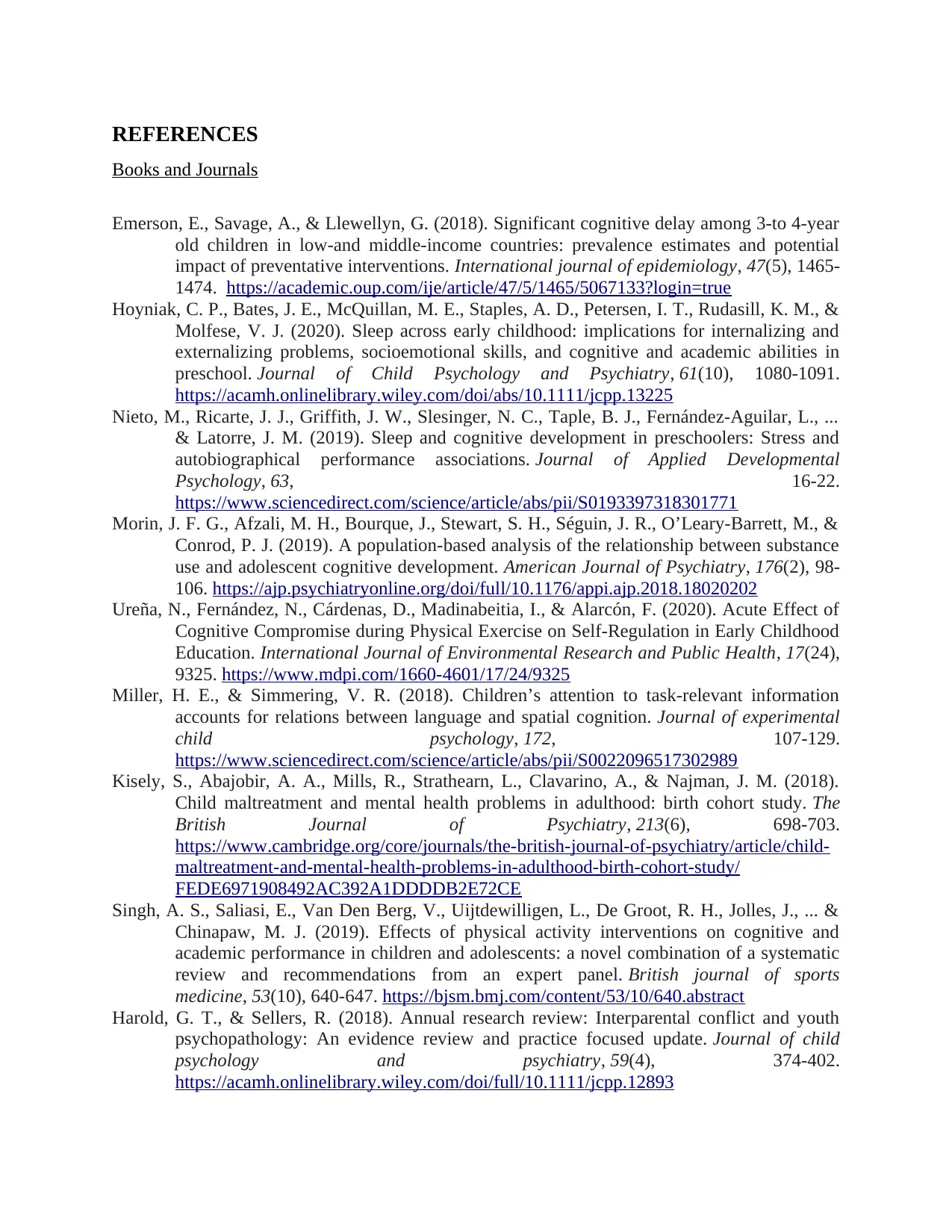
REFERENCES
Books and Journals
Emerson, E., Savage, A., & Llewellyn, G. (2018). Significant cognitive delay among 3-to 4-year
old children in low-and middle-income countries: prevalence estimates and potential
impact of preventative interventions. International journal of epidemiology, 47(5), 1465-
1474. https://academic.oup.com/ije/article/47/5/1465/5067133?login=true
Hoyniak, C. P., Bates, J. E., McQuillan, M. E., Staples, A. D., Petersen, I. T., Rudasill, K. M., &
Molfese, V. J. (2020). Sleep across early childhood: implications for internalizing and
externalizing problems, socioemotional skills, and cognitive and academic abilities in
preschool. Journal of Child Psychology and Psychiatry, 61(10), 1080-1091.
https://acamh.onlinelibrary.wiley.com/doi/abs/10.1111/jcpp.13225
Nieto, M., Ricarte, J. J., Griffith, J. W., Slesinger, N. C., Taple, B. J., Fernández-Aguilar, L., ...
& Latorre, J. M. (2019). Sleep and cognitive development in preschoolers: Stress and
autobiographical performance associations. Journal of Applied Developmental
Psychology, 63, 16-22.
https://www.sciencedirect.com/science/article/abs/pii/S0193397318301771
Morin, J. F. G., Afzali, M. H., Bourque, J., Stewart, S. H., Séguin, J. R., O’Leary-Barrett, M., &
Conrod, P. J. (2019). A population-based analysis of the relationship between substance
use and adolescent cognitive development. American Journal of Psychiatry, 176(2), 98-
106. https://ajp.psychiatryonline.org/doi/full/10.1176/appi.ajp.2018.18020202
Ureña, N., Fernández, N., Cárdenas, D., Madinabeitia, I., & Alarcón, F. (2020). Acute Effect of
Cognitive Compromise during Physical Exercise on Self-Regulation in Early Childhood
Education. International Journal of Environmental Research and Public Health, 17(24),
9325. https://www.mdpi.com/1660-4601/17/24/9325
Miller, H. E., & Simmering, V. R. (2018). Children’s attention to task-relevant information
accounts for relations between language and spatial cognition. Journal of experimental
child psychology, 172, 107-129.
https://www.sciencedirect.com/science/article/abs/pii/S0022096517302989
Kisely, S., Abajobir, A. A., Mills, R., Strathearn, L., Clavarino, A., & Najman, J. M. (2018).
Child maltreatment and mental health problems in adulthood: birth cohort study. The
British Journal of Psychiatry, 213(6), 698-703.
https://www.cambridge.org/core/journals/the-british-journal-of-psychiatry/article/child-
maltreatment-and-mental-health-problems-in-adulthood-birth-cohort-study/
FEDE6971908492AC392A1DDDDB2E72CE
Singh, A. S., Saliasi, E., Van Den Berg, V., Uijtdewilligen, L., De Groot, R. H., Jolles, J., ... &
Chinapaw, M. J. (2019). Effects of physical activity interventions on cognitive and
academic performance in children and adolescents: a novel combination of a systematic
review and recommendations from an expert panel. British journal of sports
medicine, 53(10), 640-647. https://bjsm.bmj.com/content/53/10/640.abstract
Harold, G. T., & Sellers, R. (2018). Annual research review: Interparental conflict and youth
psychopathology: An evidence review and practice focused update. Journal of child
psychology and psychiatry, 59(4), 374-402.
https://acamh.onlinelibrary.wiley.com/doi/full/10.1111/jcpp.12893
Books and Journals
Emerson, E., Savage, A., & Llewellyn, G. (2018). Significant cognitive delay among 3-to 4-year
old children in low-and middle-income countries: prevalence estimates and potential
impact of preventative interventions. International journal of epidemiology, 47(5), 1465-
1474. https://academic.oup.com/ije/article/47/5/1465/5067133?login=true
Hoyniak, C. P., Bates, J. E., McQuillan, M. E., Staples, A. D., Petersen, I. T., Rudasill, K. M., &
Molfese, V. J. (2020). Sleep across early childhood: implications for internalizing and
externalizing problems, socioemotional skills, and cognitive and academic abilities in
preschool. Journal of Child Psychology and Psychiatry, 61(10), 1080-1091.
https://acamh.onlinelibrary.wiley.com/doi/abs/10.1111/jcpp.13225
Nieto, M., Ricarte, J. J., Griffith, J. W., Slesinger, N. C., Taple, B. J., Fernández-Aguilar, L., ...
& Latorre, J. M. (2019). Sleep and cognitive development in preschoolers: Stress and
autobiographical performance associations. Journal of Applied Developmental
Psychology, 63, 16-22.
https://www.sciencedirect.com/science/article/abs/pii/S0193397318301771
Morin, J. F. G., Afzali, M. H., Bourque, J., Stewart, S. H., Séguin, J. R., O’Leary-Barrett, M., &
Conrod, P. J. (2019). A population-based analysis of the relationship between substance
use and adolescent cognitive development. American Journal of Psychiatry, 176(2), 98-
106. https://ajp.psychiatryonline.org/doi/full/10.1176/appi.ajp.2018.18020202
Ureña, N., Fernández, N., Cárdenas, D., Madinabeitia, I., & Alarcón, F. (2020). Acute Effect of
Cognitive Compromise during Physical Exercise on Self-Regulation in Early Childhood
Education. International Journal of Environmental Research and Public Health, 17(24),
9325. https://www.mdpi.com/1660-4601/17/24/9325
Miller, H. E., & Simmering, V. R. (2018). Children’s attention to task-relevant information
accounts for relations between language and spatial cognition. Journal of experimental
child psychology, 172, 107-129.
https://www.sciencedirect.com/science/article/abs/pii/S0022096517302989
Kisely, S., Abajobir, A. A., Mills, R., Strathearn, L., Clavarino, A., & Najman, J. M. (2018).
Child maltreatment and mental health problems in adulthood: birth cohort study. The
British Journal of Psychiatry, 213(6), 698-703.
https://www.cambridge.org/core/journals/the-british-journal-of-psychiatry/article/child-
maltreatment-and-mental-health-problems-in-adulthood-birth-cohort-study/
FEDE6971908492AC392A1DDDDB2E72CE
Singh, A. S., Saliasi, E., Van Den Berg, V., Uijtdewilligen, L., De Groot, R. H., Jolles, J., ... &
Chinapaw, M. J. (2019). Effects of physical activity interventions on cognitive and
academic performance in children and adolescents: a novel combination of a systematic
review and recommendations from an expert panel. British journal of sports
medicine, 53(10), 640-647. https://bjsm.bmj.com/content/53/10/640.abstract
Harold, G. T., & Sellers, R. (2018). Annual research review: Interparental conflict and youth
psychopathology: An evidence review and practice focused update. Journal of child
psychology and psychiatry, 59(4), 374-402.
https://acamh.onlinelibrary.wiley.com/doi/full/10.1111/jcpp.12893
Paraphrase This Document
Need a fresh take? Get an instant paraphrase of this document with our AI Paraphraser
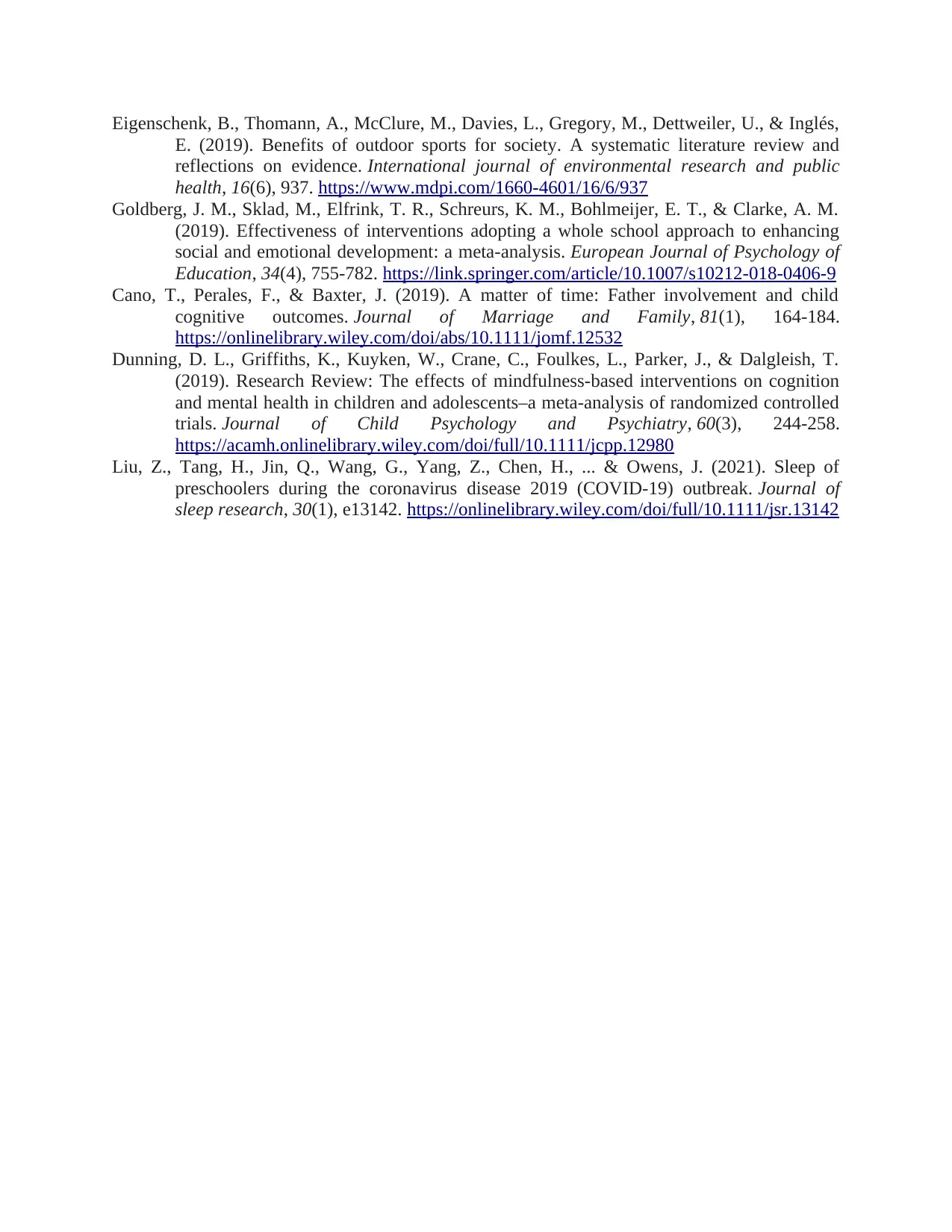
Eigenschenk, B., Thomann, A., McClure, M., Davies, L., Gregory, M., Dettweiler, U., & Inglés,
E. (2019). Benefits of outdoor sports for society. A systematic literature review and
reflections on evidence. International journal of environmental research and public
health, 16(6), 937. https://www.mdpi.com/1660-4601/16/6/937
Goldberg, J. M., Sklad, M., Elfrink, T. R., Schreurs, K. M., Bohlmeijer, E. T., & Clarke, A. M.
(2019). Effectiveness of interventions adopting a whole school approach to enhancing
social and emotional development: a meta-analysis. European Journal of Psychology of
Education, 34(4), 755-782. https://link.springer.com/article/10.1007/s10212-018-0406-9
Cano, T., Perales, F., & Baxter, J. (2019). A matter of time: Father involvement and child
cognitive outcomes. Journal of Marriage and Family, 81(1), 164-184.
https://onlinelibrary.wiley.com/doi/abs/10.1111/jomf.12532
Dunning, D. L., Griffiths, K., Kuyken, W., Crane, C., Foulkes, L., Parker, J., & Dalgleish, T.
(2019). Research Review: The effects of mindfulness‐based interventions on cognition
and mental health in children and adolescents–a meta‐analysis of randomized controlled
trials. Journal of Child Psychology and Psychiatry, 60(3), 244-258.
https://acamh.onlinelibrary.wiley.com/doi/full/10.1111/jcpp.12980
Liu, Z., Tang, H., Jin, Q., Wang, G., Yang, Z., Chen, H., ... & Owens, J. (2021). Sleep of
preschoolers during the coronavirus disease 2019 (COVID‐19) outbreak. Journal of
sleep research, 30(1), e13142. https://onlinelibrary.wiley.com/doi/full/10.1111/jsr.13142
E. (2019). Benefits of outdoor sports for society. A systematic literature review and
reflections on evidence. International journal of environmental research and public
health, 16(6), 937. https://www.mdpi.com/1660-4601/16/6/937
Goldberg, J. M., Sklad, M., Elfrink, T. R., Schreurs, K. M., Bohlmeijer, E. T., & Clarke, A. M.
(2019). Effectiveness of interventions adopting a whole school approach to enhancing
social and emotional development: a meta-analysis. European Journal of Psychology of
Education, 34(4), 755-782. https://link.springer.com/article/10.1007/s10212-018-0406-9
Cano, T., Perales, F., & Baxter, J. (2019). A matter of time: Father involvement and child
cognitive outcomes. Journal of Marriage and Family, 81(1), 164-184.
https://onlinelibrary.wiley.com/doi/abs/10.1111/jomf.12532
Dunning, D. L., Griffiths, K., Kuyken, W., Crane, C., Foulkes, L., Parker, J., & Dalgleish, T.
(2019). Research Review: The effects of mindfulness‐based interventions on cognition
and mental health in children and adolescents–a meta‐analysis of randomized controlled
trials. Journal of Child Psychology and Psychiatry, 60(3), 244-258.
https://acamh.onlinelibrary.wiley.com/doi/full/10.1111/jcpp.12980
Liu, Z., Tang, H., Jin, Q., Wang, G., Yang, Z., Chen, H., ... & Owens, J. (2021). Sleep of
preschoolers during the coronavirus disease 2019 (COVID‐19) outbreak. Journal of
sleep research, 30(1), e13142. https://onlinelibrary.wiley.com/doi/full/10.1111/jsr.13142
1 out of 14
Related Documents
Your All-in-One AI-Powered Toolkit for Academic Success.
+13062052269
info@desklib.com
Available 24*7 on WhatsApp / Email
![[object Object]](/_next/static/media/star-bottom.7253800d.svg)
Unlock your academic potential
© 2024 | Zucol Services PVT LTD | All rights reserved.




